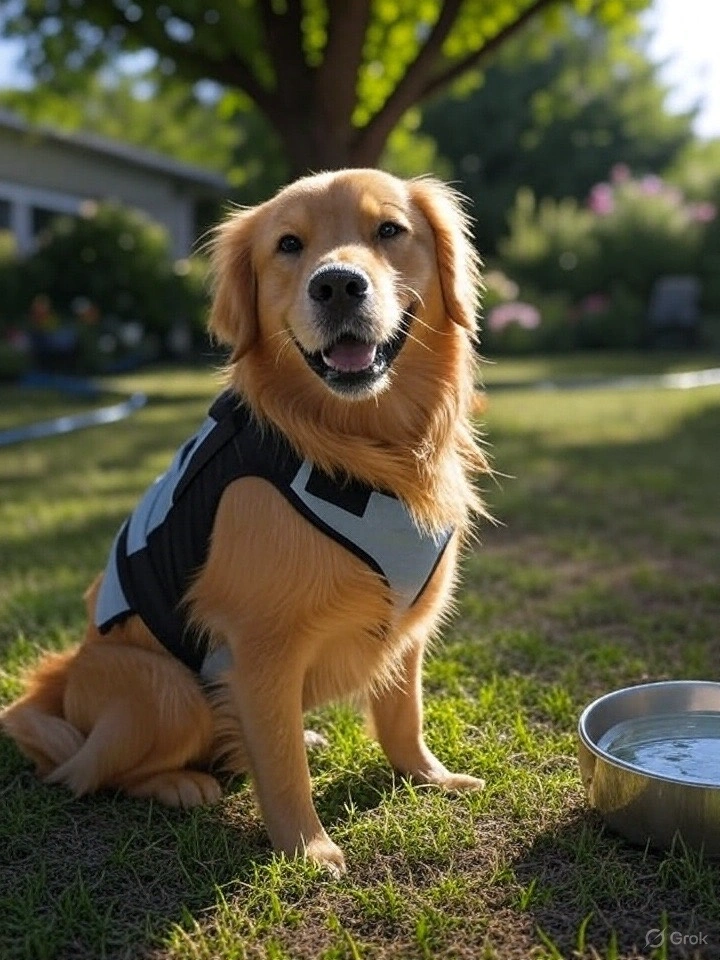Summer brings warmth and sunshine, but for our furry companions, the rising temperatures can pose serious risks. Heatstroke in pets is a life-threatening condition that can harm dogs, cats, and other animals if not addressed properly. Unlike humans, pets rely on limited mechanisms like panting to regulate their body temperature, making them highly susceptible to overheating. In this comprehensive 4,500-word guide, we’ll explore practical and actionable strategies to prevent heatstroke in dogs and prevent heatstroke in cats. From tips on how to keep dogs cool and keep cats cool to proper pet diet in summer and emergency measures, this article equips you with everything you need to ensure your pet enjoys a safe and comfortable summer.

Why Is Heatstroke in Pets Dangerous?
Heatstroke in pets occurs when a pet’s body temperature rises beyond its ability to cool down, typically above 104°F (40°C). Pets, especially dogs and cats, lack efficient cooling systems like human sweating. Instead, they rely on panting and limited sweat glands in their paw pads, which can be overwhelmed in extreme heat. This makes them vulnerable to heatstroke, which can lead to organ damage, brain swelling, or even death if not treated promptly. Certain breeds, such as short-nosed dogs (e.g., Bulldogs, Pugs) or long-haired cats (e.g., Persians), are at higher risk due to their physical traits.
Recognizing the Signs of Heatstroke in Pets
Identifying the symptoms of heatstroke in pets is critical for early intervention. Common signs include:
- Excessive or rapid panting
- Excessive drooling or salivation
- Rapid heartbeat
- Lethargy or weakness
- Bright red or pale gums
- Vomiting or diarrhea
- Seizures or collapse in severe cases
If you notice any of these symptoms, act immediately by moving your pet to a cooler area and contacting a veterinarian.
Practical Tips to Prevent Heatstroke in Pets
To ensure your pet stays safe during hot weather, proactive measures are essential. Below are proven strategies for pet care in summer to keep dogs cool and keep cats cool.
1. Provide Constant Access to Fresh, Cool Water
One of the most effective ways to prevent heatstroke in pets is ensuring they have access to fresh, cool water at all times. Pets lose more fluids in summer due to panting, so hydration is critical. Keep their water bowl filled and consider adding ice cubes to maintain a refreshing temperature. When traveling or going for walks, carry a portable water bottle and bowl for your pet.
For high-quality pet water bowls designed to keep water cool, check out the selection at Petco. Their products are perfect for maintaining hydration during hot summer days.
2. Create a Cool and Shaded Environment
To keep dogs cool and keep cats cool, ensure their living space is shielded from direct sunlight. If your pet spends time outdoors, provide a shaded area with a canopy or umbrella. Indoors, use fans or air conditioning to maintain a comfortable temperature. For outdoor pets, regularly wet the ground with cool water to prevent it from becoming too hot, as heated surfaces can burn sensitive paw pads.
3. Schedule Walks Wisely
Walking your dog during the hottest parts of the day (typically 10 AM to 3 PM) increases the risk of heatstroke in pets. Opt for early morning or late evening walks when temperatures are cooler. Avoid walking on hot asphalt or concrete, which can burn your dog’s paws. A quick test is to place your hand on the ground for 5 seconds—if it’s too hot for you, it’s too hot for your pet.
4. Adjust Their Pet Diet in Summer
A proper pet diet in summer can help regulate body temperature and support hydration. Offer lighter meals with high water content, such as wet food or homemade treats like frozen yogurt or fruit. Avoid heavy, fatty foods that require more energy to digest, as they can increase body heat. Consult your vet to tailor your pet’s diet to their specific needs during hot weather.
5. Use Cooling Accessories
Cooling accessories are excellent tools for pet care in summer. Products like cooling mats, vests, or bandanas can significantly reduce your pet’s body temperature. These items are designed to stay cool for hours, providing relief during outdoor activities or hot days. You can find a variety of cooling products at Chewy, including mats and vests suitable for both dogs and cats.
6. Never Leave Pets in Parked Cars
One of the leading causes of heatstroke in pets is being left in a parked car. Even with windows partially open, the temperature inside a car can skyrocket within minutes, reaching over 120°F (49°C) on a warm day. Always take your pet with you or leave them at home in a cool environment.
7. Grooming for Summer Comfort
Regular grooming helps keep dogs cool and keep cats cool by removing excess fur that traps heat. For long-haired breeds, a summer trim can make a big difference, but avoid shaving too close to the skin, as fur provides some protection from sunburn. Brush your pet regularly to remove loose hair and prevent matting, which can hinder airflow to the skin.
Emergency Actions for Heatstroke in Pets
If you suspect your pet is suffering from heatstroke, act quickly to lower their body temperature:
- Move them to a cool, shaded area immediately.
- Offer small amounts of cool (not cold) water to drink.
- Wet their body with cool water, focusing on the head, neck, and underbelly, but avoid ice-cold water, which can cause shock.
- Use a fan to promote air circulation.
- Contact a veterinarian as soon as possible for professional care.
Time is critical in treating heatstroke, so don’t delay seeking veterinary help.
Educational Video on Pet Care in Summer
For a visual guide on keeping your pet safe in hot weather, watch this informative YouTube video from a trusted source:
This video provides practical tips and demonstrations on how to prevent heatstroke in pets, making it a valuable resource for pet owners.
Frequently Asked Questions (FAQs) About Preventing Heatstroke in Pets
1. What are the first signs of heatstroke in pets?
The first signs include excessive panting, drooling, lethargy, and red or pale gums. If your pet shows these symptoms, move them to a cool area and contact a vet immediately.
2. How can I keep dogs cool during outdoor activities?
Provide plenty of water, schedule activities for cooler times of the day, use cooling vests or mats, and avoid hot surfaces like asphalt that can burn their paws.
3. How do I keep cats cool in summer?
Ensure they have access to shaded areas, fresh water, and a cool indoor environment. You can also use cooling mats and brush their fur regularly to remove excess hair.
4. What is the best pet diet in summer?
Opt for wet food or hydrating treats like frozen yogurt. Avoid heavy, fatty foods, and consult your vet for a summer-appropriate diet plan.
5. Can certain breeds be more prone to heatstroke in pets?
Yes, breeds like Bulldogs, Pugs, and Persians are more susceptible due to their short noses or thick fur, which hinders heat regulation.
6. What should I do if I can’t avoid taking my pet out in the heat?
Carry water, use cooling accessories, take frequent breaks in shaded areas, and monitor for signs of overheating. Avoid prolonged exposure to heat.
7. How can I tell if a surface is too hot for my pet’s paws?
Place your hand on the surface for 5 seconds. If it’s too hot for you, it’s too hot for your pet. Consider using pet booties for extra protection.
Conclusion
Preventing heatstroke in pets is all about preparation and vigilance. By ensuring access to fresh water, creating a cool environment, scheduling activities wisely, and monitoring your pet’s behavior, you can help them thrive during the summer months. Incorporate a proper pet diet in summer, use cooling accessories, and never leave your pet in a hot car. If you suspect heatstroke, act quickly to cool them down and seek veterinary care. With these tips, you can keep your furry friend safe, happy, and comfortable all summer long.
For more resources on pet care in summer, explore trusted retailers like Petco and Chewy for cooling products and hydration solutions tailored to your pet’s needs.
